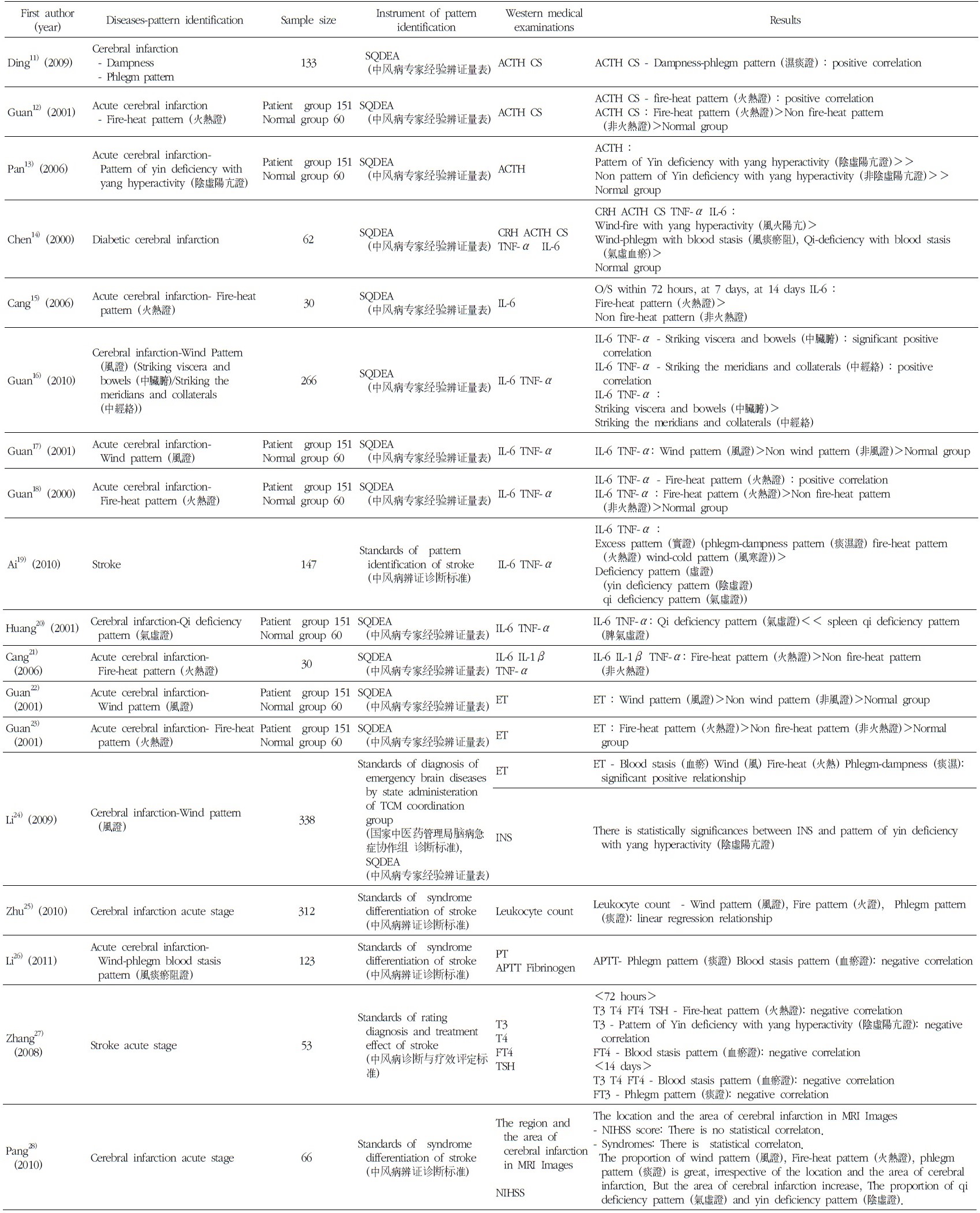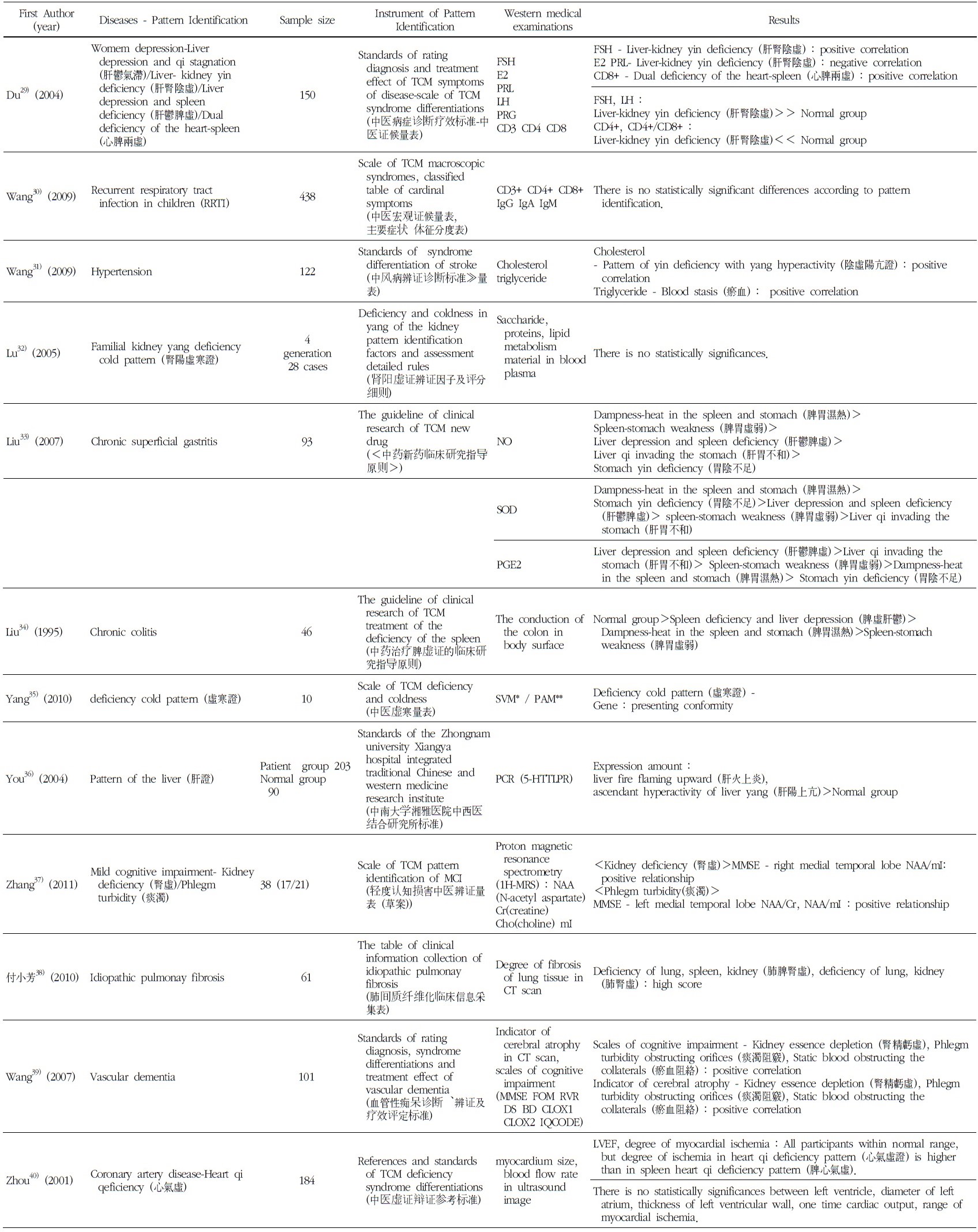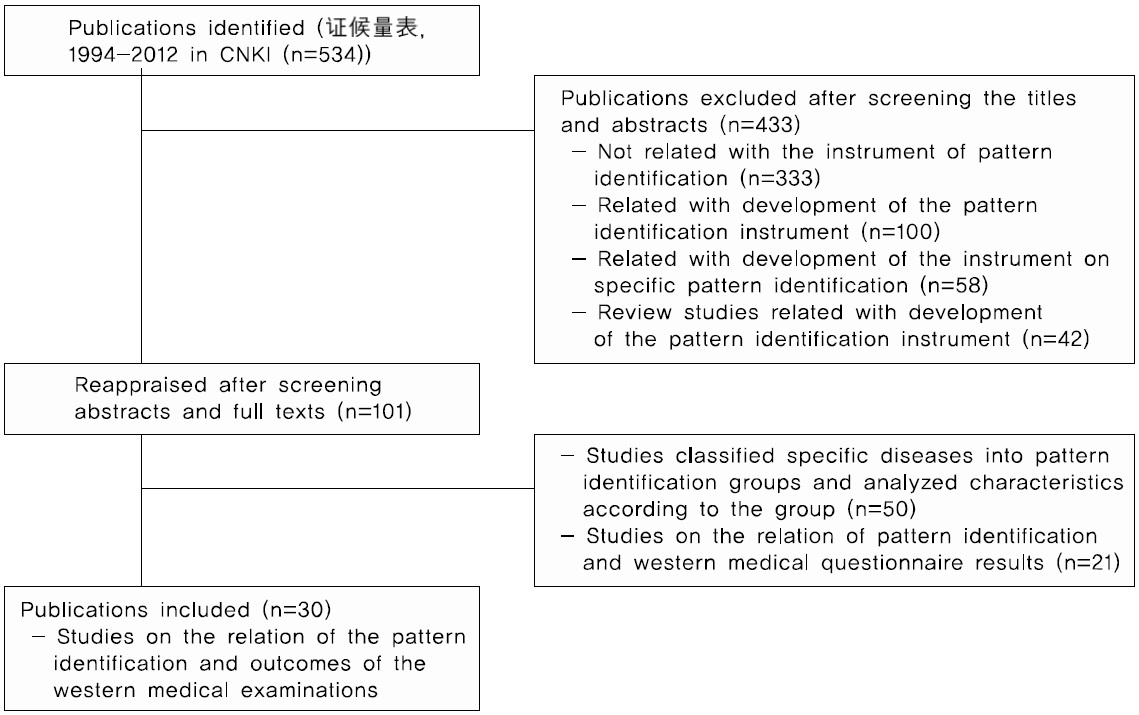



최근 한의학계에서는 변증의 객관화를 위해 용어의 표준화를 시도하고 있으며, 그 노력의 일환으로 문진에 대한 정량화 연구로 설문지를 이용하고 있다. 이에 따라, 보다 신뢰성 있는 변증도구 개발이 요구되어 지고 있으나 변증의 전제가 되는 다양한 증상개념이나 용어에 관하여 표준화된 내용은 미약하며 변증도구 개발에 어려움이 있다1).
변증도구 개발에 관한 한의학적 연구로 Yang1) 등은 어혈변증설문지, Bae 등2)은 열변증설문지, Koo3)는 우울증 병증 설문지의 개발에 관한 논문 등이 있으며 Kwon 등4)은 어혈변증설문지로 오십견의 평가를 시도하였다. 또한 Lee5), Yoon6), Cho7)는 각각 귀비탕, 보중익기탕, 육미지황탕의 변증설문지에 관한 연구를 발표한 바 있다. Haa8)와 Kim9)은 각각 평위산과 귀비탕 변증 설문지와 체성분, 위전도, 맥박변이도 등의
생체신호 간의 상관성을 연구하였고, Kim10)은 보중익기탕 변증설문지와 위전도의 상관성을 연구하는 등 설문지 개발에서 나아가 다른 검사와의 연관성을 찾으려는 시도도 있었다. 그러나 아직은 다양한 질환별 변증설문지나 모든 질환을 아우르는 설문지 개발에 관한 연구 수가 많지 않고 양방검사와의 상관성에 관한 논문도 부족한 실정이다.
중국에서도 중의변증 설문지나 점수표로 변증의 규범화, 객관화를 이루기 위한 연구들이 진행되고 있고, 다양한 질환의 변증 분류나 변증별 특징 연구에 이러한 도구를 사용하고 있다. 이에 본 연구에서는 중의학 변증도구와 다른 양방검사 결과를 비교한 논문을 조사하여 변증도구와 양방 검사와의 상관성을 살펴보고 향후 한의학 변증도구 개발 연구에 양방검사 결과를 활용할 수 있는 가능성을 찾아보고자 하였다.
대표적 중국논문 검색 database인 CNKI (中?期刊全文?据?)에서 검색하였다. 검색조건은 1994년에서 2012년으로 하였고 검색영역(field)은 ‘제목’, ‘초록’, ‘키워드’ 등을 모두 포함하는 기본검색인 ‘주제’로 하였다. 검색어는 누락을 방지하기 위해 한국어의 변증설문지 혹은 변증스케일의 의미에 해당하는 ‘?候量表'의 1가지만으로 하였다(Fig. 1).
2012년 4월 23일부터 4월 26일까지 검색된 모든 논문의 제목을 검토하여 변증설문지 및 변증도구와 관련이 없는 논문을 1차적으로 배제하였다. 이후 분류기준에 대한 연구자 간의 논의를 거쳐, 논문의 초록과 본문내용을 검토하여 변증도구 개발 관련 논문, 기존 변증도구로 단순히 특정 질환 군의 변증 분류만하거나 변증별 특징만을 분석한 논문 등은 제외하기로 하였다. 또한 수행한 양방검사의 종류에 따라 실험실검사와 영상검사 결과만을 분석에 포함시키고 양방설문지나 삶의 질 척도는 제외하였다. 변증도구를 이용해 변증한 후 양방검사와의 상관성을 연구한 논문만을 최종 분석 대상에 포함시키기로 하였다.
논문 검색과 선정은 제일 제이 저자 2인이 독자적으로 수행하여 결과를 비교하였으며, 의견이 불일치할 때는 교신저자와 함께 토론하여 이견을 조정하였다.
최종적으로 선정된 양방검사와의 상관성에 관한 논문들에 대해서는 대상이 된 특정 질병 및 변증명, 연구 대상 수, 변증도구, 양방검사 항목, 유의한 차이를 보인 검사항목을 조사하였다. 그리고 이를 바탕으로 하여 각 항목별 논문수를 조사하였다.
상기 검색어로 검색 결과 총 534편의 논문이 검색되었다. 이 중 제목만 검토하여 333편의 논문을 1차로 제외하였다. 이후 세부 분류 기준에 따라 재분류하여 변증도구 개발 관련 논문 100편과 기존 변증도구로 단순히 특정 질환 군의 변증 분류만 하거나 변증별 특징만을 분석한 논문 50편도 배제하였다. 이후 변증도구와 양방 설문지를 비교한 논문 21편을 배제하였으며, 최종 선정된 논문은 변증도구와 각 양방검사와의 상관성을 분석하고 있는 논문 총 30편이 포함되었다.
선정된 논문 30편을 질환별로 분류하면 중풍(뇌경색)이 18편으로 가장 많은 수를 차지하고 있었고, 그 외 질환이 12편이었다. 논문의 세부사항은 질환에 따라 중풍은 Table 1에, 그 외 질환은 Table 2에 정리하였다.
1) 중풍
중풍관련 논문에서 가장 많이 사용된 중의변증도구는 ≪中?病?家??辨?量表≫로 중풍 18편 논문 중 13편에서 사용되고 있었다. 그 외 4편에서는 ≪中?病辨????准≫, 나머지 1편에서는 ≪中?病????效?定?准≫가 변증도구로 사용되고 있었다.
18편을 양방검사 종류에 따라 재분류하면 실험실 검사 17편, 영상검사 1편으로 나눌 수 있었다. 실험실 검사 항목으로는 면역세포인자(IL-6 TNF-

Studies on the Correlation Between the Instrument of Pattern Identification and Western Medical Examinations (Stroke)

Studies on the Correlation Between the Instrument of Pattern Identification and Western Medical Examinations (Diseases Other than Stroke)
병변 부위의 위치, 면적에 따른 중의학 변증과의 상관관계에 관해 분석한 논문이 1편 있었다.
중풍 관련 논문에서는 변증별 점수 혹은 변증에 따라 양방검사항목에서 모두 통계적으로 유의한 결과를 나타내어 변증별로 각 양방 검사 항목 간 차이가 있음을 보이고 있었다.
2) 중풍 외 질환
기타 질환을 다룬 12편의 논문에는 허한증 2편, 만성천표성위염, 만성결장염, 소아 반복호흡기감염, 폐간질섬유화, 경도인지장애, 혈관성치매, 고혈압, 관상동맥질환, 여성우울증, 간증이 각 1편씩 포함되었다.
변증도구는 질환에 따라 다양하게 사용되고 있었는데 허한증 2편은 각각 ≪????辨?因子及?分??≫와 ≪中??寒量表≫로, 만성천표성위염은 ≪中?新??床?究指?原?≫, 만성결장염은 ≪中?治?脾??的?床?究指?原?≫에 따라 변증을 하였다. 소아반복호흡기 감염에는 ≪中?宏??候量表≫, ≪主要症??征分度表≫, 폐간질섬유화는 ≪肺????化?床信息采集表≫, 건망성 경도인지장애는 ≪?度?知?害中?辨?量表(草案)≫, 혈관성치매는 ≪血管性痴???, 辨?及?效?定?准≫을 각각 변증도구로 하였다. 고혈압은 중풍관련 논문에서도 쓰인 ≪中?病辨????准≫ 量表가 쓰이고 있었고, 관상동맥질환에는 ≪中??????考?准≫, 여성 우울증에는 ≪中?病症???效?准 - 中??候量表≫, 간증에는 ≪中南大?湘雅?院中西??合?究所?准≫가 쓰이고 있었다.
관련 양방검사 항목으로는 FSH E2 Prolactin LH Progesterone 등의 내분비 호르몬, CD3 CD4 CD8IgG IgA IgM 등 면역관련인자, 당, 단백질, 지질대사 물질 등 혈액검사, NO, SOD, PGE2의 위점막 보호인자 등 실험실검사와 PCR, SVM, PAM 등의 유전자 분석, 양성자 자기공명 분광법(1H-MRS), CT, 심초음파, 체표 결장 전도 등 질환에 따라 다양하였다.
가족성 신양허한증의 변증점수가 당, 단백, 지질대사와 상관관계가 없다는 연구결과와 반복호흡기감염 소아에서 변증과 면역지표들과 상관관계가 없다는 연구를 제외한 모든 논문에서 변증점수와 검사 항목간에 유의한 상관성을 보인다고 보고하였다.
변증을 표준화 하고자 하는 연구는 중의학에서도 활발하게 이루어지고 있는데, 정량화된 진단표준의 제정을 핵심 내용으로 하고 있다. 1980년대부터 많은 연구자들이 규범화된 중의증후 진단표준의 제정을 위한 연구 사상과 방법론을 제안하고 있으며 특히 최근의 현대 과학기술의 발전, 다학제 간의 교류 등은 이 영역의 연구에 새로운 활력이 되고 있다. 증후진단 규범화에 대한 중국 내부의 평가는 다년간의 연구로 어느 정도의 성과는 이루었으나 여전히 많은 과제가 남아있다고 본다. 첫째, 방법학의 차이로 인해 통일된 표준의 제정이 어렵다. 둘째, 증상의 가중치가 불명확하고 주관성이 강하다. 셋째, 상관 학문의 방법론이 실제 활용하기에 부족하다. 넷째, 구체적 방법론이 실제 중의임상의 요구에 긴밀히 부합하지 못하고 있다는 점 등이 과제로 지적되고 있다41).
중의이론의 규범화 연구는 주로 證病 분야에 집중되어 있으며, 중국은 국가차원에서 각종 규범화된 교재, ≪中?病?分??代?≫,≪中?病????效?准≫, ≪中?新??床?究指?原?≫등 관련 표준들을 연이어 제정하였다. 그러나 이러한 표준들 간에도 내용이 불일치하는 부분이 많아 실제 사용 과정에서 다시 모순이 발생하고 있는 실정이다.
변증논치에서 증후의 확정은 四診에 의거하는데 그중 問診이 가장 중요하여 問診에서 얻어진 症狀이 변증논치의 주요 근거가 된다. 그러나 객관적 지표 또한 경시할 수 없는데 특히 현대의 과학기기로 찾아낼 수 있는 객관적 지표가 중시되고 있다. 이는 소위 ‘微觀辨證’으로, 최근에는 분자수준에서 證의 본질을 이해하는 것이 가능하다는 연구들이 나오고 있다. 이를 통해 證의 현대 생리병리적 기전을 밝힐 뿐 아니라 특정 證에 따르는 체내 대사 이상의 변화를 추측할 수 있게 하며 동시에 미관적으로도 證을 반영하는 객관적 지표를 찾아낼 수 있어 중의학 변증의 내용을 풍부하게 하고 변증의 정확률을 높이고 있다고 평가되고 있다42).
본 연구에서는 중의변증도구와 양방검사와의 상관성을 알아보기 위해 변증도구와 양방의 실험실 생화학검사, 영상검사 등을 비교한 논문을 조사한 결과 여러 질환에서 변증과 양방검사 간 상관관계가 있다는 결론을 얻고 있어 중의학 ‘변증’과 서양의학 ‘진단’간 소통의 가능성을 시사하였다.
먼저 중풍 관련 논문에서는 중풍의 火熱辨證과 양방 검사지표 중 ACTH 및 IL-6, TNF-
또한 강력한 혈관 수축인자인 ET 수치 역시 중풍 변증의 風證이나 火熱證과 밀접한 상관관계를 나타냈다. 두 편의 논문에서 火熱證과 非火熱證으로 나누었을 때와 風證과 非風證으로 그룹을 나누었을 때 각각 火熱證과 風證에서 ET 농도가 유의하게 높게 나타났고, 또 다른 한 편의 논문에서 血瘀證, 風證, 火熱證, 痰濕證이 ET 농도와 현저한 상관관계를 나타냈다. 이는 중풍 발병 후 72시간 이내의 환자들에서 火熱證, 痰證, 風證의 점수가 높게 나왔던 연구결과와 관련하여 봤을 때 氣虛證이나 陰虛證의 虛證보다는 實證에서, 또한 火熱證이나 風證처럼 뇌조직 손상 후 급성기에 나타날 수 있는 변증유형에서 ET 농도가 높게 나타날 수 있다는 의미로 해석된다.
우리나라에서도 최근 몇 년간 한의학 변증과 양방 검사들과의 상관성을 밝히는 연구가 증가하고 있는 추세인데, 중풍환자에 관한 연구를 보면 Shin43)은 뇌경색 환자의 동맥경화와 한방 변증과의 관련성을 보았는데 CAVI에 의해 측정된 동맥경화도가 어혈과 밀접한 관계를 가져 어혈의 진단이 동맥경화의 유효한 예측인자로 사용 가능한 것으로 보았다. 또한 Park44)의 연구에서는 경동맥 초음파를 이용한 뇌경색 환자의 내경동맥 협착도와 습담 변증과의 관련성을 연구해 ‘severe internal carotid artery stenosis'군은 습담변증군과 유의한 관련성이 있음을 밝혔다. 반면 Shin45)은 5개 변증과 혈중 지질의 상관관계를 연구하였으나 변증별로 유의한 차이를 보이지 않아 고지혈증이라는 특정 질환은 한방적 특정 변증에 국한되지 않는다고 하였다. 이는 중풍이라는 질병이 어느 정도의 지질 이상 및 동맥경화 등의 위험요인과 혈관상태의 불량이라는 공통적인 결과물로 나타난 것이기 때문으로 보았다.
한국에서의 중풍 이외의 질병에 관한 연구를 보면 Lee46)는 다한증 환자의 한의학적 변증 특성 및 자율신경계 기능을 비교한 결과 한열, 양증, 실증에서 자율신경계와 유의한 상관관계가 있다고 하였다. 또한 Sin47)은 흉부 X선으로 우폐의 종횡비와 체지방, 체성분 분석 및 변증설문검사와의 상관성에 관한 연구를 하였고, Kim48)은 생혈액검사와 기혈진액변증의 상관성에 대해 연구하였다.
한국과 중국의 연구들을 비교해보면 먼저 중풍에 대해서는 중국에서 훨씬 많은 표본수를 대상으로 다양한 생화학적 검사 지표들(면역 매개 인자, 내분비호르몬, 혈액응고인자, 백혈구수), 영상 검사 소견과의 상관성을 다루고 있으며, 한국에서는 중국에 비해 중풍과 다양한 양방검사 간의 상관성 연구가 부족하였다. 또한 검색된 중국 논문 중에는 동일한 저자가 하나의 지표와 각 중풍 변증과의 상관성을 밝힌 일련의 논문들이 포함되어 있어 집중적인 연구를 수행하는 그룹이 있음을 알 수 있었다.
또한 중풍 이외의 다양한 질병에 대해 질병별로 변증과 다양한 양방검사항목 간의 상관성을 연구하였다. 예를 들어 여성우울증의 변증과 내분비 호르몬과 면역관련 인자와의 상관성 연구, 건망성 경도인지 장애, 폐간질섬유화, 혈관성 치매의 변증과 영상학적 소견과의 상관성 연구, 虛寒證, 肝證의 변증과 유전자 발현도에 관한 연구 등이 있었다. 이들 연구를 통해 중국에서는 생화학적 검사지표 뿐 아니라 생물유전학적 정보, 영상의학 소견 등 다양한 양방검사 항목을 변증의 방법으로 도입하기 위한 시도를 하고 있는 것을 알 수 있었다. 그러나, 중의학 변증도구는 질병별로 각각 다르게 사용하고 있어 통일된 거시적 변증도구의 부재를 보여주었다.
이상의 연구결과에서 중국에서는 다양한 질환에 대해서 한의학 변증과 양방검사 항목 간의 상관성을 조사하는 연구가 이루어지고 있음을 알 수 있었다. 본 연구에서 살펴본 30개의 연구 중 소아반복호흡기 감염과 가족성 신양허한증에 대한 2개의 연구를 제외하고는 모두 양방검사와 유의한 상관관계를 보여 한의학적 변증에 다양한 양방검사를 도입할 수 있는 가능성을 시사하였다고 할 수 있다. 본 연구는 향후 한의학계에서 다양한 질환에서의 변증의 객관화, 표준화와 변증과 양방진단과의 소통을 위한 연구의 참고 자료가 될 수 있으리라 사료된다.
본 연구의 한계점은 다음과 같다.
논문 검색 과정에서 검색어를 ‘?候量表’로 한가지로만 해 ‘?候’와 ‘量表’가 동시에 포함되어 있는 논문들은 모두 검색되었으나, ‘진단표준’이나 ‘설문지(?卷)’로 변증한 논문들이 누락되었다. 실제 변증도구와 양방검사와의 상관성 논문을 완전히 찾으려면 더 다양한 검색어로 논문 검색을 진행해야 할 것이다.
논문 분류 과정에서 제목만으로 변증도구가 아닌 치료 효과에 초점을 두고 있는 임상 논문들을 1차적으로 배제하였는데 이 과정에서 많은 검사관련 논문들이 누락되었을 가능성이 있다.
향후 더 다양한 검색법과 분류법을 통해 중의변증 도구와 양방검사와의 상관성에 관한 연구들을 정리할 필요가 있을 것이다.
중국 논문 검색 database인 CNKI를 이용해 검색어 ‘?候量表’로 검색하고 일정한 기준에 따라 분류하고 선정한 뒤 분석한 결과 다음과 같은 결론을 얻었다.
중의변증도구와 양방검사와의 상관성을 살핀 논문 30편 중 질환별로는 18편이 중풍과 관련검사의 상관성을 연구하고 있어 가장 많은 비율을 차지하고 있었고 나머지 질환이 12편 이었다.
30편의 논문 중 2편을 제외하고는 모두 중의변증과 양방검사 항목 간에 유의성 있는 상관관계를 보이고 있어 중의학 변증과 양방의학 진단간 소통의 가능성을 시사하고 있었다.
중풍관련 논문 중에는 변증도구로 ≪中?病?家??辨?量表≫를 사용한 논문이 13편으로 가장 많았으며 실험실검사항목으로는 면역세포인자(IL-6 TNF-α)가 8편으로 가장 많았다. 영상검사는 MRI와 관련된 논문이 1편에 불과해 중풍에서 영상검사와 중의변증과의 상관성 연구가 부족한 것으로 보인다.
중풍 외 질병을 다룬 연구들에서는 통일된 변증 도구보다는 질환별로 다양한 변증도구를 사용하고 있었고, 양방검사항목도 각 질환의 특징에 따라 실험실검사에서 영상검사, 유전자분석까지 다양하였다.


